|
|
|
|
PAKISTANI
CURRENCY |
|
|
|
|
|
|
|
|
|
|
|
|
|
|
|
|
|
|
|
|
|
 |
|
At
the time of partition of India and Pakistan in 1947 the Reserve
Bank of India was functioning as Central Bank of the undivided India.
As it was not possible to set up a separate Central Banking Institution
in Pakistan immediately after partition, emergency arrangements
were put into place for the circulation of currency in Pakistan.
The Governor General of undivided India issued the 'Pakistan (Monetary
System and Reserve Bank) Order, 1947' on 14th August 1947. Under
this order, the Reserve Bank of India was to be common authority
for India and Pakistan until 30th September 1948. |
|
|
|
|
|
|
|
|
|
|
|
|
|
|
|
|
|
|
|
|
|
|
|
|
|
|
 |
|
'Pakistan
(Monetary System and Reserve Bank) Order, 1947' allowed for Indian
Notes to be modified for use in Pakistan and to be placed into circulation
from 1st April 1948. The modification to the Indian Notes consists
of two inscriptions on the front of the Notes "Government of Pakistan"
in English at top, while "Hakumat-e-Pakistan" at bottom of the white
area reserved for viewing the watermark were inscribed. The inscribed
Notes were in the denomination of 1, 2, 5, 10 and 100 Rupee.
It is important to note that these inscriptions are due to modifications
to the printing plates and they are not 'overprints'. |
|
|
|
|
|
|
|
|
|
|
|
|
|
|
|
|
|
|
|
|
|
|
|
|
|
 |
|
After
the formation of State Bank of Pakistan, Government issued emergency
series of bank Notes on 1st October 1948, with the denominations
of 5, 10 and 100 Rupees. It was prepared by Thomas De La Rue & Company
of Great Britain.
The 5-Rupee Note was deep Blue, 10-Rupee Note was oficially described
as red but it was more an orange and the 100-Rupee Note was rich
green color. To the right, on the front of each Note, was a crescent
moon and star, while to the left the denomination of each note is
written in Urdu numerals. There is neither watermark nor security
thread on any note in this series with the signature of Ghulam Muhammad,
Pakistan's first Finance Minister. |
|
|
|
|
|
|
|
|
|
|
|
|
|
|
|
|
|
|
|
|
|
|
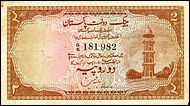 |
|
On
1st March 1949, 1 and 2 Rupee Notes were issued. Both Notes were
printed by Bradbury Wilkinson & Company of Great Britain. The
1 Rupee Note was issued on behalf of the Government of Pakistan,
while the 2 Rupee Note was issued by the State Bank of Pakistan.
The 1 Rupee Note was green, with a crescent moon and star on front
and an illustration of the Naulakha Pavilion on back. The 2 Rupee
Note was brown, with an illustration of a tower from tomb of Jahangir
on the front and the Badshahi Mosque appears on the back.
A series of proposed designs of 5, 10 and 100 Rupee Notes was
put to the Central Board of the State Bank by the Governor on
16th August 1948 and proofs were submitted to the Government for
approval. The illustration for the 5 and 10 Rupee Notes were approved
but the design for the 100 Rupee Note was rejected.
The 100 Rupee Note had an illustration of the building used as
the headquarters of the State Bank in Karachi on its front. The
Government rejected this design because the building occupied
by the State Bank in Karchi was a rented building, and they decided
that a building that was not owned by the State Bank should not
be depicted on a banknote.
On 1st September 1951 the first 5 and 10 Rupee Notes were issued
on behalf of State Bank of Pakistan and had been printed by Thomas
De La Rue in Britain. The 5 Rupee Note had an illustration of
boat with jute on front and Khyber Pass on back. The 10 Rupee
Note had an illustration of Shalimar Garden on front and Makli
Tomb on back, both Notes carried the watermark of the crescent
moon and star.
In March 1951 the Board of the State Bank released a 100 Rupee
Note in a similar pattern to the existing issue as a temporary
measure with some alterations.
The new and first 100 Rupee Note with the signature of State Bank
Governor (Zahid Hussain) was issued on 15th September 1953.
|
|
|
 |
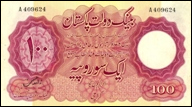 |
|
|
|
|
|
|
|
|
|
|
|
|
|
|
| |
|
|
|
|
|
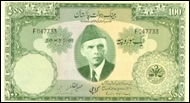 |
|
In
1956, the Joint Secretary Cabinet inform the Cabinet that according
to some reliable source, there was an offically sponsored organization
in Calcutta which were forging Pakistani currency notes on a big
scale, that were in circulation in India. In this connection it
was suggested that the new series of Pakistani Bank Notes with a
portrait of Mr. Muhammad Ali Jinnah should introduced.
In this regard the 100 Rupee Note was issued on 24th December, 1957.
It was predominantly green in color, a portrait of Mr. Muhammad
Ali Jinnah, watermark of Mr. Jinnah and a security thread on front
and the illustration of the Badshahi Mosque on back of the Note
were introduced.
This series continued with the introduction of a new 50 Rupee Note
on 12th June 1964, 500 Rupee Note on 28th October 1964, 5 Rupee
Note on 19th September 1966 and 10 Rupee Note on 16th November 1970.
|
|
|
 |
|
|
|
|
|
|
|
|
|
|
| |
|
|
|
|
|
|
|
|
|
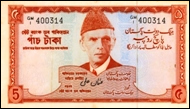 |
|
During
the Civil War many Notes of the State Bank were stolen and bundles
of banknotes were being stamped with slogans in Bengali and English,
slogans such as 'Joy Bangla' and 'Bangla Desh', then being released
into circulation in East Pakistan.
Then Pakistani Government decided to take action against the looters
and propagandists. On 8th June 1971 the Pakistani authorities declared
all currency carrying inscriptions of 'Joy Bangla', 'Bangla Desh'
or any similar expression, or which were marked with 'Dacce', to
no longer be legal tender. In addition, all 100 and 500-Rupee Notes
were no longer to be legal tender.
Pakistan demonetized the remaining Notes and prepared a new series
of 1, 5, 10, and 50-Rupee. In new series the design of the Notes
remains same but the colors were changed. The 1-Rupee Note became
brown, the 5-Rupee Note became ochre, the 10-Rupee became green,
and the 50-Rupee Note became blue. The only new note that was not
based on an existing design was the 100 Rupee Note. It was issued
on 1st March 1972, with the portrait of Mr. Jinnah to the left on
front and an illustration of Badshahi Mosque on the back. |
|
|
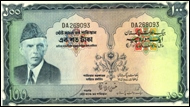 |
|
|
|
|
|
|
|
|
|
|
|
|
|
|
|
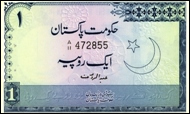 |
|
Due
to the secession of East Pakistan there was no need for Bengali
text to appear on the notes and the images of tea gardens and jute-laden
boats were no longer appropriate for banknotes circulating in the
new Pakistan.
The first note in the new generation of Notes was a 1-Rupee Note,
introduced on 16th May 1974. It was predominantly blue, with a crescent
moon and star at the right. Along the bottom of the note is panel
in which the words 'One Rupee' are repeated in four regional languages.
Starting from the right, the text reads: 'Ik rupee (Punjabi) Hik
rupee (Sindhi) Yo rupee (Pushto) Yuk rupee (Baluchi)'. The back
of the Note was also blue and carries an illustration of the 'Minar-e-Pakistan.
The circulation of this 1-Rupee Note was short-lived. It was replaced
because the use of four regional languages was seen as promoting
provincialism. The new 1 Rupee Notes was placed into circulation
on 15th April 1975.
This series continued with the introduction of new 5, 10 and 100 Rupee
Notes on 12th July 1976, 50 Rupee Note on 29th December 1977, 2
Rupee Note on 24th August 1985, 500 Rupee Note on 1st April 1986
and 1000 Rupee Note on 18th July 1988. |
|
|
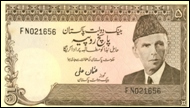 |
|
|
|
|
|
|
|
|
|
|
|
|
|
|
| |
|
|
|
|
|
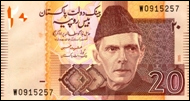 |
|
Due to modern forgery techniques, State Bank of Pakistan to overcome this situation decided to use new technology with more added security features in printing of banknotes by PSPC.
On 13th August 2005, State Bank of Pakistan introduced 20 Rupee Banknotes in the history of Pakistan with added security features and an era of latest printing technology started. It was brown in color, with portrait of Mohammad Ali Jinnah on the front and Mohenjo Daro at the back.
This series contains Rs. 5, 10, 20, 50, 100, 500, 1000 & 5000 denomination notes.
The highest denomination note of this series Rs. 5000 was introduced on 27th May 2006. It was the first time that a currency note of 5000 denomination was introduced. It is mustard in color with Quaid's portrait at the front and Faisal Mosque, Islamabad at the back of the note. |
|
|
 |
|
|
|
|
|
|
|
|
|
|
|
|
|
|
Courtesy: Peter Symes |
|
|
|
|
|
|
|
| |
